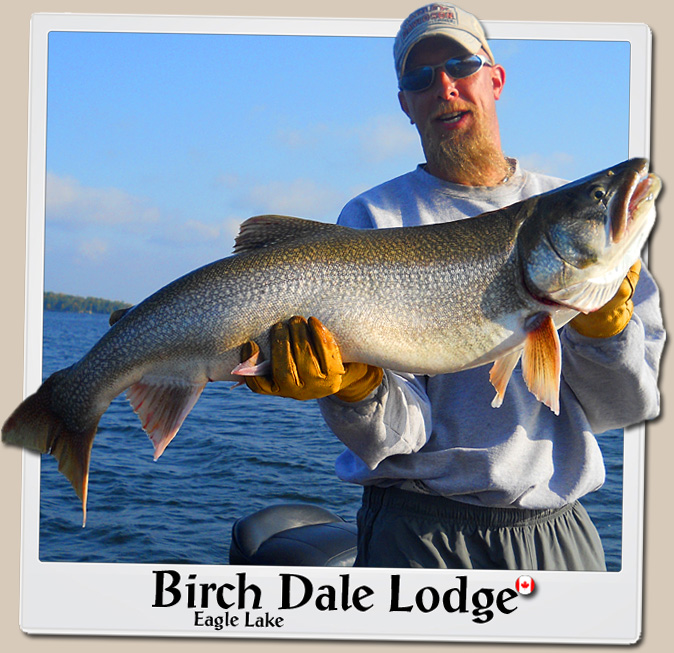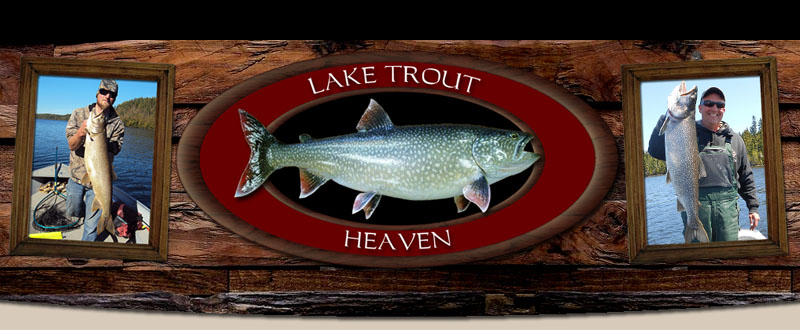Welcome to Lake Trout Heaven
 Ontario has the top inland lakes in Canada with Monster Trophy fish. Only a small percentage of people visiting Ontario have tapped into the great Laker fishing as Ontario has a reputation for other species.
Ontario has the top inland lakes in Canada with Monster Trophy fish. Only a small percentage of people visiting Ontario have tapped into the great Laker fishing as Ontario has a reputation for other species.
Ontario is farther south than Canada's Arctic so it seems the Lakers are not as common as they are in Arctic but this is far from the truth. Ontario has the highest population of Lakers and the most lakes of any province in Canada. They are just a little deeper in Ontario due to warmer surface water but still easy to catch with my deep water tips and techniques.
All the lodges, outpost camps & resorts in this web site have outstanding fishing including a few camps that claim they have the very best fishing in Ontario. We have research documents, which are expert fishing tips and techniques for catching trout in the summer down deep with light action equipment. You do not need steel wire or down-riggers to catch fish if you have a regular size boat.
About the Lake Trout in Ontario's Inland Lakes
Their scientific name is Salvelinus Namaycush. They are also known by many other names such as Mackinaws or Gray Trout with it's Cree Indian name being Touladi. The Lakers are a species of char and it's closest relative is the Arctic Char, which both are indigionous species to North America and a major fishing target in Ontario.Lakers are found in hundreds of deep-water lakes in Ontario and even though they seem like a rare and elusive fish they are actually quite common in Ontario. The perception people have is based on not knowing how to fish for them or not spending any time fishing for them; a problem we solve on this fishing website. The best eating size Laker is 1/2 to 5 pounds. Stories about them being an oily fish are totally not true. They taste fantastic and are far superior in flavour to Rainbows or Browns, which taste more like salmon.
Lakers are usually found in cool and deep rocky lakes. They are a cold-water species and in the summer they go deep to find cooler water. Many people seem to think they go to the bottom of the lake and are not accessible. Generally on Ontario's inland lakes they rarely go below 55 feet deep when feeding. They require a minimum dissolved oxygen level of 6 parts per million or greater to be actively hunting. They can survive in lower oxygen levels but their bodies go into a state of hibernation and that does not mean good fishing. The boundary separating higher and lower oxygen levels is caused by different water temperatures and this is called the thermocline. Just above the thermocline is where the greatest number of feeding fish will be. They will shoot up into shallower water for short periods of time to raid schools of Lake Herring, Shad, Cisco and Chub. Early morning and evening you will find the best fishing depth to be around 40 to 50 feet. This is different on every lake. In spring fed lakes you can catch them in 15 feet of water in the middle of summer.
In large boddies of water like the Great Lakes the trout can exhibit totally different behavior than they do in smaller inland lakes. On Lake Ontario I have see people fishing 150 feet deep while I have seen people fishing Lake Superior at 20 feet deep in the heat of the summer. The great lakes are huge and have a complex current system, which is created by tides, storms and massive water flow between the lakes. You need to understand the water flow and current in the area where you are fishing. For example: In the summer warm surface water from Lake Erie runs over Niagara Falls carrying sediment. When the water reaches Lake Ontario it drops a lot of sediment forming a large sand bar at the mouth of the river. If you are at the mouth of the river you will see the main water flow heads left from the sand bar. The flow of warm water sucks icy cold water up from the depths hitting the outside of the sand bar on the right side. In the middle of the summer you can catch fish 20 to 30 feet deep in this icy up-flow because the Lakers sit in the cold water waiting for minnows that are attracted to the warm water. They are waiting for minnows to venture out of the warm water into striking distance. Lakers do not have a tolerance for warmer water like Browns Trout or Brookies but they will swim out into warm water for a short period of time to snatch minnows.
Lake Trout Growth Rate in Ontario Lakes
Trout will grow 4 inches per year for the first two years and then 2 inches per year for the next six years. After that they will only grow 3/4 of an inch per year.Lets say a fish is 38 inches long.
A = 8 (first 2 years)Trout on the Great Lakes can grow much faster than on smaller inland lakes.
B = 12 (next 6 years)
C = 38 (length in inches)
D = .75 (growth per year after 8 years)Age = A + B + ((C-(8+12))/D)
Age = 8 + 12 + 24
Age = a 38-inch Laker on average is 44 years old on inland lakes.
Lakers can reach great sizes. The Ontario trout fishing record is just over 63 pounds and was a world record for 39 years until broken in 1995 when a 72.5 pound Lake Trout was caught on Great Bear Lake in the Northwest Territories. Recently at Plummer's Lodge on Great Bear Lake there was a 78.85 pound trout that was caught and released and is the unofficial World Record Lake Trout at this time. In 1961 a 102 pound trout (not while fishing) was net in Lake Athabasoc and in 1998 a 104 pound Lake Trout was net in Lake Nipigon, Ontario by the Ontario MNR, which makes it the largest Laker every recorded. It just goes to show you Ontario is a trophy producer. There are some bodies of Water in the province like the Great Lakes and Lake Nipigon, which produce Lakers just as big as Northwest Territories, Nunavut or the Yukon.
Please explore my web site and check out the lodges and the information I have collected. I want you to come to Ontario and have a fantastic fishing trip. Email me at gary@laketrout.org if you need help.
NS-1


